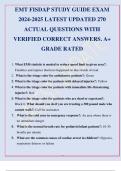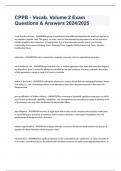EMT FISDAP STUDY GUIDE EXAM
2024-2025 LATEST UPDATED 270
ACTUAL QUESTIONS WITH
VERIFIED CORRECT ANSWERS. A+
GRADE RATED
1. What EMS statistic is needed to reduce speed limit in given area?:
Fatalities and injuries that have happened on that stretch of road
2. What is the triage color for ambulatory patients?: Green
3. What is the triage color for patients with delayed injuries?: Yellow
4. What is the triage color for patients with immediate life-threatening
injuries?: Red
5. What is the triage color for patients who are dead or expectant?:
Black 6. What should you do if you are treating a 300 pound male who
cannot walk?: Call for assistance
7. What is the cold zone in emergency response?: An area where there is
no immediate danger
8. What is the normal breath rate for pediatric/infant patients?: 18-30
breaths per minute
9. What are the common causes of cardiac arrest in children?: Hypoxia,
respiratory distress or failure
,10. What are the characteristic symptoms of croup?: Hoarseness,
'barking' cough, inspiratory stridor, respiratory distress
11. What are the steps to treating bleeding?: Apply direct pressure, use a
tourniquet if direct pressure does not stop the bleeding
12. What are the signs and symptoms of meningitis?: Fever, rash, stiff
neck, altered mental status
13. What is the Apgar scale used for?: Assessing the appearance, pulse,
grimace, activity, and respiration of a newborn
14. What is the primary concern when treating an allergy?: Airway
15. When should chest compressions be started on a newborn?: If the
pulse is under 60 beats per minute
16. What are the signs and symptoms of a ruptured spleen in a child?:
Bleeding and pain in the right upper quadrant
17. What organs are located in the right upper quadrant of the
abdomen?: Liver, right kidney, colon, pancreas, gallbladder
18. What organs are located in the left upper quadrant of the abdomen?:
Liver, spleen, left kidney, stomach, colon, pancreas
19. What is located in the left lower quadrant of the abdomen?: Part of
the descending colon, sigmoid colon, left ovary and tube, left ureter, left
spermatic cord 20. What organs are located in the right lower
quadrant of the abdomen?: Cecum, appendix, right ovary and tube,
right ureter, right spermatic cord
21. What are the signs and symptoms of epiglottitis?: Sudden onset, high
fever, 'hot-potato' voice, dysphagia, drooling, no cough, prefers to sit upright
and lean forward
, 22 What is left lateral recumbant position?: Position to relieve pressure on
heart and vena cava.
23. What are some questions for a pregnant mom?: How many weeks
along are you? How far apart are contractions?
24. What are the signs of imminent delivery?: Crowning, urge to bear
down, 'It's Coming', increased frequency & intensity of contractions.
25. What is preclampsia?: Abnormal condition in pregnancy with high
blood pressure, proteinuria, and edema.
26. What is eclampsia?: True toxemia of pregnancy characterized by high
blood pressure, albuminuria, edema of the legs and feet, severe
headaches, dizziness, convulsions, and coma.
27. What are the signs and symptoms of ovarian cysts?: Lower pain on
either side, nausea, bleeding, ask when last menstrual cycle was.
28. What are the signs and symptoms of PID (Pelvic Inflammatory
Disease)?: Onset is usually after menses. Sudden pelvic pain, profuse
vaginal exudate, fever, metrorrhagia, discharge.
29. When should you massage the fundus?: To stop bleeding and
cramping after delivery.
30. What should you do if a woman is bleeding after a sexual assault?:
Use a pad or sterile gauze and put it under her to collect the blood.
31. What is a breech birth?: Baby is delivered feet or buttocks first.
32. When can you insert a gloved finger into the vaginal canal?: If the
umbilical cord is around the baby's neck.
33. What is perineum tearing?: Tearing from the vagina to the anus after
delivery.





